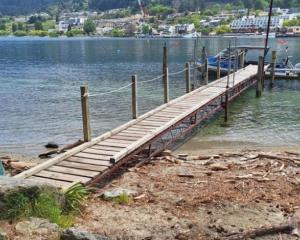The Department of Conservation's 37-year-old Gardiner Hut was knocked from its foundations by a huge rock avalanche from the south face of Mt Cook earlier this week and it is unclear whether it can be salvaged.
The hut sits above the Hooker Glacier and is the fourth in the national park which has either been destroyed or become unusable in the past two decades.
De La Beche Hut was demolished in 2012 because of extensive deterioration; Beetham Hut was destroyed by an avalanche about 20 years ago and the Hooker Hut was now recommended by Doc as an emergency shelter only because of safety issues.
Dave McKinley, chief guide for Mt Cook-based Alpine Guides, said the damage to the hut was a major concern to the mountaineering community.
''We're losing those back-country assets and they're not being replaced and obviously I understand it's a budget thing but it's quite noticeable for those users.
With Gardiner Hut now closed indefinitely, of the three huts that were once in the Hooker Valley, only Empress Hut remained, Mr McKinley said.
It was the highest in the Mt Cook National Park at 2500m above sea level and was only accessible to experienced mountaineers after a long day's travel over ''heavily crevassed'' country.
''Everybody that comes to Mt Cook , whether they're a geriatric visitor or a keen young mountaineer, they all get to Mt Cook and they look straight up the Hooker Valley and less and less people actually walk up the Hooker Valley and spend the night up there because there's less and less places for them to do so.
''There's lots of resources and pretty signs in a car park where a busload of overseas tourists will spend five minutes taking photos. We'll spend an awful lot of money making that car park look pretty. But the back-country shelter for a person that walks deep into the mountains, the options are becoming limited.''
While the shell of Gardiner Hut building looked like it might be salvageable, it would not be a quick or cheap fix, he believed.
Doc conservation services manager Mike Davies said the department was waiting on a geological assessment by GNS Science before a decision was made on the future of the hut, which had sustained ''considerable'' damage in the rock avalanche. Doc shared mountaineers' concerns about the decline in back-country shelters, Mr Davies said.
''They are the stakeholders who have a very clear interest in these things, so that's what will be part of our consideration in terms of the future of [Gardiner Hut].
''For us it's a huge blow to lose another hut ... So then it puts into focus all of the other huts.''
The ''down-wasting'' of glaciers had made access to high alpine huts increasingly difficult.
''We do recognise that you're dealing with a very dynamic landscape and these things will always be an issue and we can't always anticipate things.''
A proposal was still in the pipeline to move Hooker Hut to a safer location, Mr Davies said. However, he would have to look into the background of the other huts to determine why they had not been replaced, he said.












